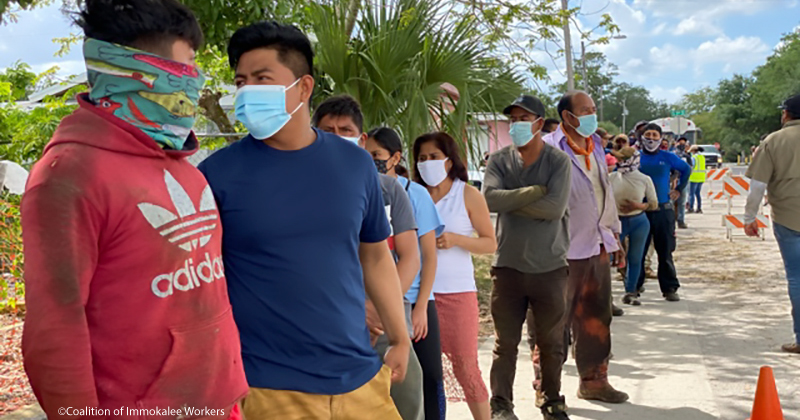Funding Cuts for COVID Care, Testing, & Vaccination for Uninsured Threatens Lives & Increases Disparities for Food & Farmworkers

[Editor’s Note: It’s César Chávez Day, and the end of National Farmworker Awareness Week. Are you aware of the health risks that food and farmworkers are still taking to plant, tend, harvest, and process our food? As the COVID pandemic wears on, the risks may unfortunately be growing once more.]
On March 22, a massive shift in COVID testing and treatment silently slipped onto the books. As of that day, the federal government under the COVID-19 Uninsured Program stopped paying for tests and medical bills related to COVID for uninsured patients. As of April 5, the program will also cut off funding for vaccinations of uninsured patients.
As the nation braces for another wave prompted by the Omicron subvariant BA.2, community health centers, health departments and other health delivery sites across the country who serve largely uninsured food and farmworkers are fearing an increase in need while simultaneously juggling a drastic drop-off in funding.
“Once again, the workers who put food on our tables, the same workers hailed as essential, stand to bear the brunt of the next wave, as it is these workers and their families who remain uninsured or underinsured,” noted Amy K. Liebman, MPA, Director of Environmental and Occupational Health for Migrant Clinicians Network.
Since the very first days of the pandemic, food and farmworkers have been on the frontlines, working at factories and in fields when most other businesses were shuttered. As COVID-19 spread across the US, food and farmworkers were among the most disproportionately affected, as a result of a lack of workplace protections overlayed with occupational and social factors like fear of coming forward with a complaint, substandard housing, a lack of health insurance, and more. When vaccines finally became available, advocates like MCN pushed loudly and urgently for food and farmworkers to gain access to vaccines. Much of our COVID work in the last two years has focused on equipping local communities to best reach out and support migrants, immigrants, and farmworkers, so they can access COVID vaccines. As a result of such concerted and continual efforts in rural communities around the country, the vaccine disparity gap has not just closed but reversed among Hispanic people for the initial vaccine series. As of March 2022, 63.8% of people identifying as Hispanic have received at least one COVID-19 vaccine dose, compared to 61.9% of white people.
Yet, disparities still exist in booster uptake, and significant barriers remain. With the changing landscape, those who haven’t managed to overcome the barriers to vaccination and care may have a significant new one placed in their way: cost. It is unknown at present what the costs will be; it will likely vary from state to state, with some states covering full costs and others passing some costs on to patients. While some health centers and other health care delivery sites may find other funding avenues to support vaccination, the message will continue to get across: those without insurance aren’t supported nationally. MCN remains gravely concerned for the health and well-being of food and farmworkers as we enter the newest phase of the pandemic for several key reasons:
Unique barriers to vaccination remain: While data specifically around the vaccination rates of food and farmworkers are limited, the majority of food and farmworkers identify as Hispanic, and therefore vaccination rates of Hispanic people can serve as a proxy. That said, while the overall rates for people identifying as Hispanic are encouraging, food and farmworkers often encounter numerous additional barriers to vaccination that the overall Hispanic population may be able to avoid, including fear of exposing immigration status, transportation and work barriers, misinformation, and migration. Additionally, many food and farmworkers do not have insurance. In the most recent NAWS survey, just 47% of surveyed farmworkers reported that they had health insurance. Among migrant farmworkers, 34% had health insurance. Among farmworkers without authorization to work, 24% had health insurance. These are the populations who will be most affected by the change in funding. Fear and confusion over what will be covered and what not only adds to the list of barriers to vaccination.
Booster disparities are concerning and will grow: Additionally, across the 12 states reporting data on boosters, fewer Hispanics overall are opting for the additional shot compared to other ethnicities. In California, just 41% of fully vaccinated Hispanic people have received the booster, compared to 60% of vaccinated white people, 50% of vaccinated Black people, and 65% of vaccinated Asian people.
This booster disparity is particularly concerning, given the April 5th drop-off in funding for vaccination of uninsured people; the data out of Europe and Asia that demonstrate the importance of the booster to reduce the risk of hospitalization and death from the Omicron subvariant BA.2; and the concurrent drop-off in mandates for masking, which increases the risk of exposure. Without funding for boosters for the uninsured, the disparities may continue to grow, and food and farmworkers will be left at greater risk of infection.
Lack of coverage for testing will spread the virus: If clinics aren’t clear that testing will continue to be covered, food and farmworkers and others who lack insurance may avoid testing facilities even when exposed. This test avoidance may serve to spread the virus among people who are unaware that they are infected. There should never be any barrier to testing, as increased testing keeps all of us safer from the virus and helps the public health authorities determine the prevalence of the disease.
Lack of coverage for emergency care endangers food and farmworker lives: Without clear messages about hospitalization coverage, some food and farmworkers may avoid hospitals even when very ill. This is a very concerning possibility, wherein people who desperately need care choose to forgo it for fear of financial consequences on their families. New antiviral treatments only work if a patient receives treatment early on in the infection. Delayed and avoided care will result in increased mortality.
“It’s as if we lost our collective memory overnight, forgetting the earlier days of the pandemic when farmworkers and those working in our poultry, seafood, and meat processing facilities were left with few protections,” said Liebman. “These mostly immigrant workers and their families suffered disproportionately from COVID-19. Our workers deserve so much better. Taking away funding will only lead to more suffering.”
Got some good news to share? Contact us on our social media pages above.
Return to the main blog page or sign up for blog updates here.
- Log in to post comments





